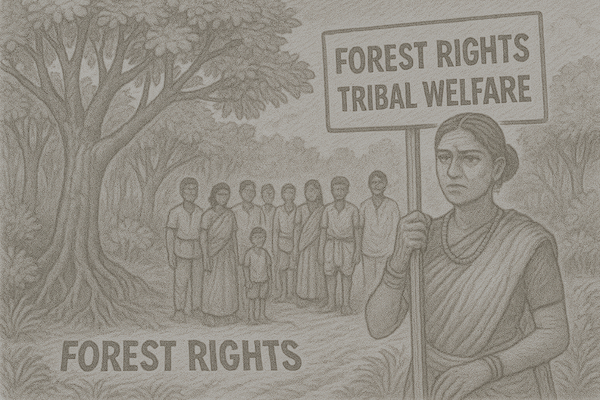In a historic first since the enactment of the Forest Rights Act (FRA), 2006, the Union Government has stepped forward to structurally support its implementation by sanctioning 324 district-level FRA cells and 17 State-level cells under the Dharti Aba Janjatiya Gram Utkarsh Abhiyaan (DAJGUA). This marks a significant policy shift from its earlier stance of leaving implementation solely to State governments and underscores a renewed commitment to realising the promise of rights for Scheduled Tribes and Other Traditional Forest Dwellers (OTFDs).
A Long-Awaited Move to Support Forest Rights Implementation
For nearly two decades, the implementation of the FRA—a law that seeks to rectify historical injustices by recognising the individual and community rights of forest-dwelling communities—has faced chronic delays, bureaucratic hurdles, and rampant rejections of claims. Of the 51.11 lakh claims filed across 21 States and Union Territories, 14.45% are still pending, and 42% of disposed cases have been rejected.
In this backdrop, the creation of FRA cells at both district and State levels is a welcome move. These cells are not intended to replace or interfere with the statutory structures established under the FRA—such as Gram Sabhas, Forest Rights Committees (FRCs), Sub-Divisional Level Committees (SDLCs), and District Level Committees (DLCs)—but to facilitate claim processing, assist Gram Sabhas in paperwork, and aid in data management.
“These FRA cells will have no role in interfering with decisions made by the Gram Sabha, SDLCs, DLCs, or State departments under the FRA,” clarified a government official. “They will merely assist claimants and Gram Sabhas.”
The Potential for Transformative Change
Effective implementation of the FRA is not just about claim approval—it represents a transformative agenda for tribal governance, cultural recognition, and environmental justice. The establishment of these support cells, if managed transparently, can accelerate several important outcomes:
-
Tribal Well-Being and Livelihood Security: Recognition of forest rights enhances access to land, forest produce, and other resources crucial for subsistence. This leads to improved food security, economic independence, and dignity for forest dwellers.
-
Protection of Traditional Practices and Cultural Identity: Forest rights legitimise and safeguard the knowledge systems, religious practices, and eco-centric lifestyles of tribal communities, who have coexisted with forests for generations.
-
Strengthening Local Governance and Democratic Decentralisation: The FRA vests immense power in the Gram Sabha, making it the statutory authority for decision-making. When FRA is implemented in true spirit, it strengthens bottom-up governance and aligns with the ideals of democratic decentralisation envisaged in the PESA Act and the 73rd Constitutional Amendment.
-
Community-Led Conservation: Contrary to popular belief, studies have shown that forest areas under community governance often have better conservation outcomes than state-controlled reserves. Empowering local communities through FRA ensures ecological stewardship aligned with local knowledge.
Limitations, Concerns, and the Road Ahead
Despite its potential, the move is not without concerns.
-
Parallel Mechanism Fears: Some activists fear that FRA cells created under DAJGUA may function as a parallel institutional framework that dilutes the FRA’s original intent of decentralised governance led by the Gram Sabha. These cells are being created under a centrally designed programme, not directly under the FRA itself.
-
High Rate of Rejections: With 42% of claims rejected and high pendency in States like Assam (over 60%) and Telangana (over 50%), the efficacy of the FRA cells will depend on whether they merely process paperwork or proactively support claimants through legal aid, training, and capacity building.
-
Centre-State Coordination: Though the cells are funded by the Centre, they are to operate within State government machinery. The functional clarity, reporting structure, and accountability mechanisms remain to be fully defined.
-
Budgetary Concerns: While ₹8.67 lakh per district cell and ₹25.85 lakh per State cell have been sanctioned, there are questions over whether this budget is sufficient for staffing, outreach, translation support, digital infrastructure, and mobility in remote tribal areas.
-
Exclusion of Nomadic and Pastoral Communities: Implementation continues to face difficulties in recognising rights of nomadic groups and pastoral communities who may not have settled claim boundaries or documentary evidence.
Bridging Policy and Practice
This is the first time that the Centre has moved beyond issuing advisories and data compilations to financially and structurally backing the Forest Rights Act’s implementation. Earlier, the Ministry of Tribal Affairs largely played an observer’s role, relegating actual responsibility to States. With this shift, the Centre seems to acknowledge that achieving the aims of FRA requires proactive institutional support and not just legislative intent.
However, the real success of these cells will depend on:
-
Their autonomy from forest departments, who often oppose FRA implementation.
-
Whether they uphold the primacy of Gram Sabhas as the decision-making body.
-
Their ability to train tribal youth, translators, and legal aides to support communities from within.
-
Creation of monitoring mechanisms that include civil society and tribal representatives.
The FRA cells under DAJGUA have the potential to catalyse a long overdue revolution in forest governance, tribal empowerment, and local democracy. But care must be taken that this support infrastructure does not override the spirit of the law it is meant to facilitate. If implemented transparently and in consultation with forest-dwelling communities, this could mark a new era of equity, justice, and sustainable governance rooted in the wisdom of India’s forest communities.






